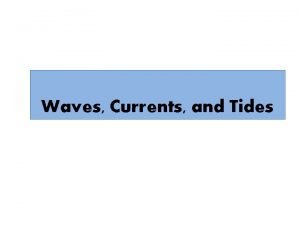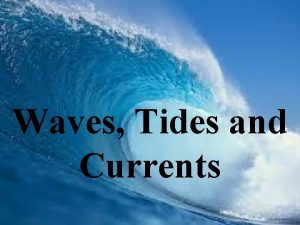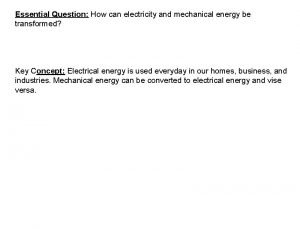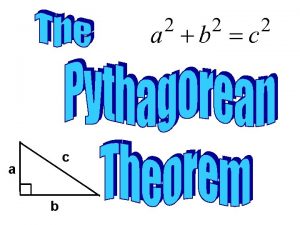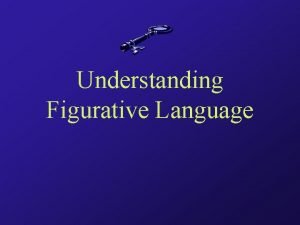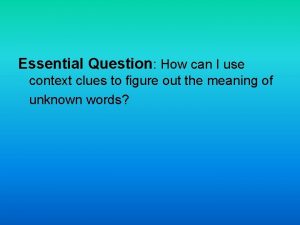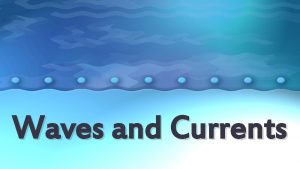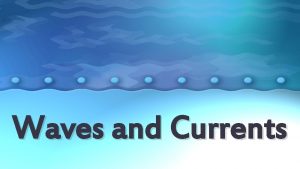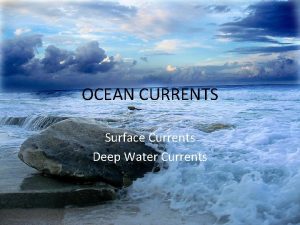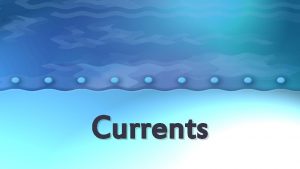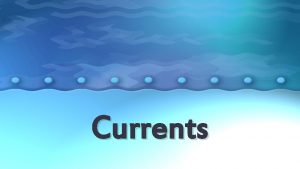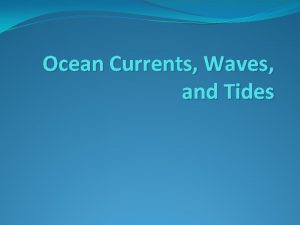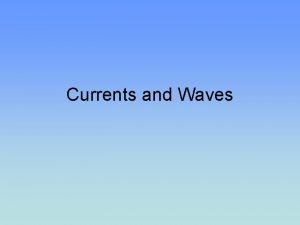Waves and Currents Essential Question How are waves





























- Slides: 29

Waves and Currents

Essential Question: How are waves and currents created? Standards: S 6 E 3 d. Explain the causes of waves, currents, and tides.

Activating Strategy: Watch the video below then answer the questions. http: //video. disney. com/watch/catching-the-eac 4 bb 39 d 25 a 179 ea 8833003 b 15 Where is this event happening? What causes the condition shown in the video? What do you think is the importance of the condition shown?

Use your notes to record important information during the lesson.

Waves A wave is a rhythmic movement that carries energy through matter and space. In the ocean, waves move through seawater.

Causes of Waves �When wind blows across a body of water, wind energy is transferred to the water �If the wind speed is great enough, the water begins to pile up, forming a wave �The height of a wave depends on: �The speed of the wind �The distance over which the wind blows �The length of time the wind blows

Causes of Waves �Once set in motion, waves continue moving for long distances, even if the wind stops blowing �The waves you see lapping at a beach could have formed halfway around the world

Ocean Currents

Ocean Currents Ocean currents are a mass flow of ocean water. Remember the “Finding Nemo” clip There are two main types of currents we will be discussing: Surface Currents and Density Currents

Ocean Currents: Surface Currents �Surface currents move water horizontally – parallel to Earth’s surface �Surface currents are powered by wind �The wind forces the ocean to move in huge, circular patterns http: //www. livescience. com/19662 animation-reveals-ocean-currents. html �There are warm surface currents and cold surface currents

Ocean Currents: Surface Currents

Ocean Currents: Surface Currents �Surface winds and surface currents are affected by the rotation of the Earth (the Coriolis Effect) http: //www. youtube. com/watch? v=dt_XJp 77 -mk �Because Earth rotates toward the east, winds appear to curve to the right in the northern hemisphere and to the left in the southern hemisphere �So, currents north of the equator turn to the right and currents south of the equator turn to the left

Ocean Currents: Surface Currents Curving of surface winds due to the Earth’s rotation

Ocean Currents: Surface Currents Surface currents north of the Equator curve to the right due to the Earth’s rotation Equator Surface currents south of the Equator curve to the left due to the Earth’s rotation

Animation of Ocean Surface Currents http: //www. classzone. com/books/earth_science/ terc/content/visualizations/es 2401 page 0 1. cfm? chapter_no=visualization Animation of Coriolis Effect http: //www. classzone. com/books/earth_science/ter c/content/visualizations/es 1904 page 01. cfm

Surface Currents Affect Climate �The ocean absorbs, stores, and moves the sun’s heat (energy) �Surface currents transport this energy all over the world �Surface currents move warmer water into cooler regions and return cooler water to the warmer regions (tropics) �Currents can have a cooling effect on an area’s climate or a warming effect on an area’s climate �As warm water flows from the equator, heat is released into the atmosphere and the air is warmed.

Surface Currents Affect Climate �Think about what you learned in social studies about Europe’s climate. What surface current makes Europe’s climate temperate (mild)? �The Gulf Stream is a surface current that moves warm water from the tropics to the cooler regions around Europe.

Surface Currents Notice again the Red arrows and the Blue arrows showing the movement of warm water and the movement of cold water

Gulf Stream and Climate http: //www. youtube. com/watch? v=Uu. Gr. Bh. K 2 c 7 U

The video reminded us that the masses of water are moved by wind, but what did they say was the primary cause of ocean currents? Different densities are responsible for ocean currents. What factors did we learn influence ocean water’s density? Temperature and Salinity Affect the Density of Ocean Water.

Temperature, Salinity and Density Ocean depth increases Density increases Temperature decreases Density decreases Salinity increases Density increases Temperature decreases because cold water is more dense and sinks

Density Currents �Deep in the ocean, waters circulate not because of wind but because of density differences. �A density current forms when a mass of seawater becomes more dense than the surrounding water. �More dense seawater sinks beneath less dense seawater. �Density currents circulate ocean water slowly.

Density Currents

Density Currents

Density Currents

Label on your diagram

Ocean Currents Song https: //www. youtube. com/wat ch? v=Nsd. H_NRM-CU

Waves & Currents Video http: //studyjams. scholastic. com/stu dyjams/science/weather-andclimate/waves-and-currents. htm

Summarizing Strategy
 Mikael ferm
Mikael ferm What is deep current
What is deep current Citlalli dominguez
Citlalli dominguez Ocean waves
Ocean waves Currents waves
Currents waves Levels of questioning
Levels of questioning Essential non essential fatty acids
Essential non essential fatty acids Compare and contrast p waves and s waves using venn diagram
Compare and contrast p waves and s waves using venn diagram Difference between electromagnetic and mechanical waves
Difference between electromagnetic and mechanical waves An example for mechanical wave
An example for mechanical wave Mechanical waves and electromagnetic waves
Mechanical waves and electromagnetic waves Carbon dioxide temperature
Carbon dioxide temperature Difference between matter waves and electromagnetic waves
Difference between matter waves and electromagnetic waves Mechanical and electromagnetic waves similarities
Mechanical and electromagnetic waves similarities Surface waves and body waves
Surface waves and body waves Mechanical waves and electromagnetic waves
Mechanical waves and electromagnetic waves Differences between constructive and destructive waves
Differences between constructive and destructive waves Essential questions about figurative language
Essential questions about figurative language Formula hipotenusa triangle rectangle
Formula hipotenusa triangle rectangle Essential question generator
Essential question generator Pythagorean theorem essential questions
Pythagorean theorem essential questions Language
Language Individual vs society
Individual vs society Essential context clues
Essential context clues What is the essential question in cornell notes
What is the essential question in cornell notes Open-ended questions examples
Open-ended questions examples Essential questions for multiplication
Essential questions for multiplication Essential question gif
Essential question gif External character traits
External character traits Cornell way
Cornell way



